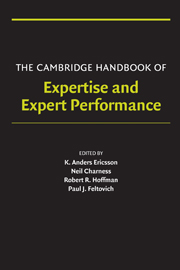Book contents
- Frontmatter
- Contents
- Acknowledgments
- Contributors
- PART I INTRODUCTION AND PERSPECTIVE
- PART II OVERVIEW OF APPROACHES TO THE STUDY OF EXPERTISE – BRIEF HISTORICAL ACCOUNTS OF THEORIES AND METHODS
- PART III METHODS FOR STUDYING THE STRUCTURE OF EXPERTISE
- PART IV METHODS FOR STUDYING THE ACQUISITION AND MAINTENANCE OF EXPERTISE
- PART V DOMAINS OF EXPERTISE
- PART V.A PROFESSIONAL DOMAINS
- 19 Expertise in Medicine and Surgery
- 20 Expertise and Transportation
- 21 Expertise in Software Design
- 22 Professional Writing Expertise
- 23 Professional Judgments and “Naturalistic Decision Making”
- 24 Decision-Making Expertise
- 25 The Making of a Dream Team: When Expert Teams Do Best
- PART V.B ARTS, SPORTS, & MOTOR SKILLS
- PART V.C GAMES AND OTHER TYPES OF EXPERTISE
- PART VI GENERALIZABLE MECHANISMS MEDIATING EXPERTISE AND GENERAL ISSUES
- Author Index
- Subject Index
- References
24 - Decision-Making Expertise
from PART V.A - PROFESSIONAL DOMAINS
- Frontmatter
- Contents
- Acknowledgments
- Contributors
- PART I INTRODUCTION AND PERSPECTIVE
- PART II OVERVIEW OF APPROACHES TO THE STUDY OF EXPERTISE – BRIEF HISTORICAL ACCOUNTS OF THEORIES AND METHODS
- PART III METHODS FOR STUDYING THE STRUCTURE OF EXPERTISE
- PART IV METHODS FOR STUDYING THE ACQUISITION AND MAINTENANCE OF EXPERTISE
- PART V DOMAINS OF EXPERTISE
- PART V.A PROFESSIONAL DOMAINS
- 19 Expertise in Medicine and Surgery
- 20 Expertise and Transportation
- 21 Expertise in Software Design
- 22 Professional Writing Expertise
- 23 Professional Judgments and “Naturalistic Decision Making”
- 24 Decision-Making Expertise
- 25 The Making of a Dream Team: When Expert Teams Do Best
- PART V.B ARTS, SPORTS, & MOTOR SKILLS
- PART V.C GAMES AND OTHER TYPES OF EXPERTISE
- PART VI GENERALIZABLE MECHANISMS MEDIATING EXPERTISE AND GENERAL ISSUES
- Author Index
- Subject Index
- References
Summary
Picture basketball coach Don Smith, who desperately needs at least a couple of outstanding free throw shooters. Coach Smith's team has lost game after game in the waning seconds. That is because opposing teams easily regain possession of the ball by committing intentional fouls since they know that Smith's players make few of their free throws. Coach Smith is pondering how to recruit a new player who has already demonstrated his proficiency at the line. He is also trying to figure out how to train a current player to elevate his free throw performance to the level of an expert. Related to this second approach, Coach Smith also has what some would call “scientific” concerns. He wonders why none of his players is already an excellent free throw shooter. What exactly is involved in foul shooting expertise? How does one normally develop the skill? Why is it that some players acquire the ability but others do not? Are there certain constitutional factors, physical or psychological, that limit a player's potential at the free throw line? If so, what are they? And how can one detect them, so that resources are not wasted “trying to make a silk purse from a sow's ear?”
Coach Smith's situation is by no means unique. In some form or another, it is replicated in countless circumstances where the focus is on making decisions rather than shooting free throws.
- Type
- Chapter
- Information
- The Cambridge Handbook of Expertise and Expert Performance , pp. 421 - 438Publisher: Cambridge University PressPrint publication year: 2006
References
- 42
- Cited by

